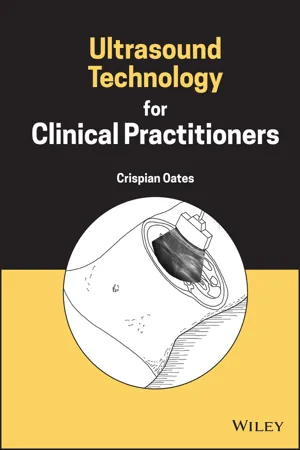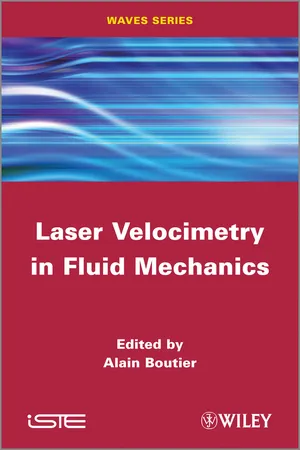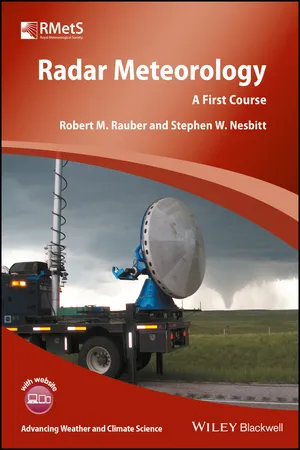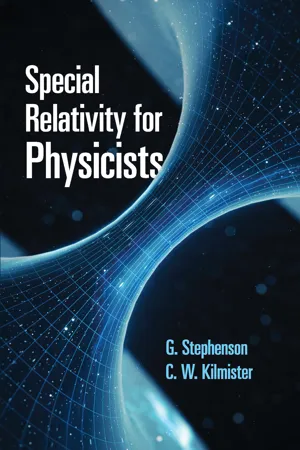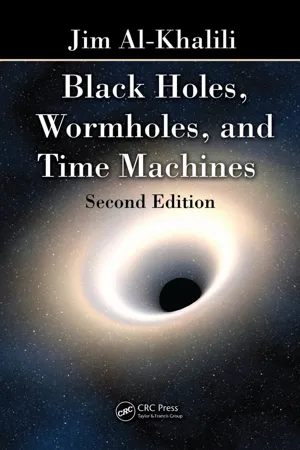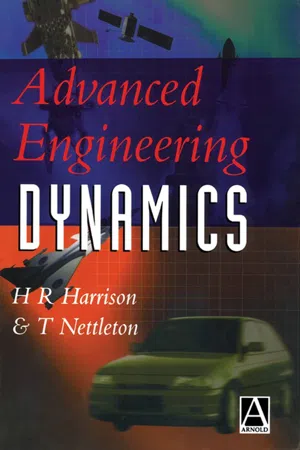Physics
Doppler Effect
The Doppler Effect refers to the change in frequency or wavelength of a wave in relation to an observer who is moving relative to the wave source. This effect is commonly observed with sound waves, where the pitch of a sound appears to change as the source or observer moves. In astronomy, it is used to determine the motion of celestial bodies based on the shift in their spectral lines.
Written by Perlego with AI-assistance
Related key terms
Related key terms
1 of 4
Related key terms
1 of 3
9 Key excerpts on "Doppler Effect"
- eBook - ePub
- Crispian Oates(Author)
- 2023(Publication Date)
- Wiley(Publisher)
8 Principles of Doppler UltrasoundTHE Doppler Effect
The Doppler Effect is the change in the detected frequency of a sine wave when there is relative motion between the transmitter and the receiver. This will occur for all wave phenomenon. It is the change in pitch you hear when a motor bike races past you. The pitch is higher as it comes towards you and drops to a lower pitch as it moves away.NOTE
For historical reasons and as it is the name of a person, Christian Doppler, who first described the effect, ‘Doppler’ is always spelt with a capital ‘D’.To see why there is this change in received frequency, consider the example of a boat rowing towards a source of waves on a lake (Figure 8.1 ). It will intercept those waves more rapidly than if the boat was stationary. If it were being rowed away from the source, the boat would intercept the waves at a lower frequency. If the boat was stationary, it would bob up and down at the same rate as the waves were being generated.In this case, the source of waves is stationary and the boat is a moving receiver.When a fire engine passes you at speed, with its sirens sounding, you hear a change in the pitch or frequency of the sound. The frequency is higher as it comes towards you and lower as it moves away. In this case, the fire engine is a moving transmitter and you are a stationary receiver.Illustration of a boat moving at velocity ‘v’ encountering wind‐blown waves moving at velocity ‘c’.FIGURE 8.1It doesn’t matter which is moving and which is stationary; it is the relative motion between the transmitter and receiver that causes the Doppler Effect.In the case of clinical ultrasound, the Doppler Effect will occur when there is relative motion between an echo target and the transducer, e.g. moving blood or cardiac wall. We can use this phenomenon to non‐invasively detect movement and measure velocities of targets within the body. - eBook - ePub
- Alain Boutier, Alain Boutier(Authors)
- 2013(Publication Date)
- Wiley-ISTE(Publisher)
3.2. Basic idea: Doppler Effect3.2.1. Double Doppler Effect
We assume that the illumination source is a laser: we shall justify this choice later when discussing formulas. The laser beam (emitting an optical frequency f 0 ) and the observer (which will be a photodetector) are stationary in the laboratory.In a first step the moving particle is a mobile observer relative to a stationary laser beam source. Due to the Doppler Effect it receives a frequency f p slightly different from f 0 .In a second step, the moving particle, which is thus a mobile source, emits the frequency f p towards the stationary observer, which receives another frequency f due to a second Doppler Effect. We compute f as a function of f 0 , the velocity vector, , and the geometry of the system defined by two unit vectors: along the direction of laser beam and along the direction of observation.3.2.1.1. Fixed source, mobile observerA laser beam of frequency f0 in a vacuum propagates along a unit vector in a medium having a refraction index n . The wavelength in the medium is:where c is the speed of light (c = 3 × 108 m/s).Figure 3.1.Doppler Effect: fixed source, mobile observerLet T 0 = f 0 –1 be the period of radiation in the vacuum; wavelength λ = cT 0 /n represents the distance between two successive wavefronts O 1 O 2 . At initial instant t 1 ; the particle (mobile observer) is at O 1 and meets a wave 1 emitted by the source. Then particle moves at a velocity to meet the next wave 2 at instant t 2 (see Figure 3.1 - eBook - ePub
- Serhii Stepanov(Author)
- 2018(Publication Date)
- De Gruyter(Publisher)
is important for the consideration of effects up to first order. However, this is not true for velocities close to the speed of sound. Here, it is important to know who (source or receiver) is moving relative to the environment, and how. This difference is essential when considering both the relativistic Doppler Effect and the classical effects of signal propagation in a medium.3.4The Doppler Effect and the twin “paradox”
There are various manifestations of the Doppler Effect. Besides the changes to the radiation spectra of moving objects, it also distorts our perception of the duration of remote processes. For example, when Ryomer first measured the speed of light in 1676 by observing the orbital periods of Jupiter’s moons, he exploited a manifestation of the Doppler Effect. The periods decreased when Earth was approaching Jupiter and increased when it was receding. The relativistic component is hard to measure at such velocities. However, the classical component is a first-order effect.Consider again the twin “paradox” from the perspective of the Doppler Effect. Suppose the brothers started transmitting their images to one another immediately after they parted. The traveller sees his brother sitting in an armchair next to the chimney, under the clock. In turn, the earth-dweller sees on his monitor the cabin of the spaceship equipped with an electronic clock over the steering wheel held by his brave travelling brother. The spaceship has to get to the nearest star and come back. Here are some extracts from the ship’s flight logbook.Travel diary .After rapidly accelerating I have reached a speed approaching the speed of light. The g-forces were enormous, but thanks to the latest achievements in biocybernetics, I withstood them easily enough. The time at which I started to travel is the same by my clock and that of my stay-at-home brother. However, the frequency of the signal I’m receiving has markedly decreased as the Earth rapidly “recedes”. The situation is not changing as the distance from Earth grows. The second hand of the clock above my brother’s chimney is barely creeping and shows a time considerably behind my own. This is a result of the Doppler Effect, combined with the delay in the video transmission due to the finiteness of the speed of light. The very bright stars up ahead look so densely crowded, while the stars behind seem notably scarce and more red in colour. The distances between the automatic beacons along my way have decreased ⟨...⟩. - eBook - ePub
Radar Meteorology
A First Course
- Robert M. Rauber, Stephen W. Nesbitt(Authors)
- 2018(Publication Date)
- Wiley-Blackwell(Publisher)
Chapter 6 Radial Velocity—The Doppler EffectObjectives
By the end of this chapter, you should understand the following:- The Doppler Effect, and how a Doppler frequency shift occurs.
- What is meant by radial velocity, and the relationship between radial velocity and the Doppler frequency shift.
- Why Doppler radars use pulse-to-pulse phase changes to measure radial velocity.
- Why Doppler radars can only measure radial velocity within a finite range.
- The Doppler dilemma and techniques to circumvent it.
- What is meant by a Doppler spectrum.
- The relationship between a Doppler spectrum and its moments.
- The pulse-pair processor algorithm to obtain Doppler spectral moments.
6.1 Introduction
Have you ever heard a train blow its whistle as it approaches and then moves away from you—although the train's sound is the same, you hear a high pitch on approach and a lower pitch on departure. On approach, sound waves are compacted because they and the train are moving in the same direction. Successive waves travel shorter distances, compressing their arrival times and increasing the frequency with which they pass a stationary observer. As the train moves away, sound waves still move toward the observer but are stretched because the train and the waves are moving in opposite directions. In this case, the frequency is decreased, lowering the pitch. The faster the train is moving, the greater the frequency shift a stationary observer hears. The frequency change is called the Doppler frequency shift after the Austrian physicist Hans Christian Doppler, who first explained the phenomenon.Microwaves emitted by radar also undergo a very slight frequency shift when they are scattered by raindrops or other targets moving toward or away from the radar. As with sound, the shift is toward higher frequencies when the targets are moving toward the radar and lower frequencies when they are moving away. The faster the targets move, the greater the frequency shift will be. A Doppler radar determines the Doppler frequency shift by measuring the phase of electromagnetic waves returned from a series of microwave pulses. From the pulse-to-pulse phase change, the radar determines the radial velocity, defined as the reflectivity-weighted velocity along the direction of the beam of all the targets within a pulse volume. As Figure 6.1 shows, the radial velocity represents a single component of motion of the targets, specifically the radial component; Doppler radars cannot detect the tangential components of target motion perpendicular to the radar beam. There are in fact four components to target motion, assuming that the targets are meteorological and move with the wind. These are the east–west wind component (u), the north–south wind component (v), the up–down wind component (w), and the target's terminal velocity in still air (wt - eBook - ePub
- Thomas L. Szabo(Author)
- 2013(Publication Date)
- Academic Press(Publisher)
θ ,(11.1A)and solving for the Doppler frequency (f D ) in terms of the transmitted frequency (f 0 ),(11.1B)leads to a Doppler shift, correct to first order when c s =c 0 ,(11.1C)Figure 11.1 Doppler-shifted wave frequencies from a moving source as seen by observers at different locations.Observers at (A) 0°, (B) 90°, (C) 180°, (D) 270°, and (E) 45° angles relative to the directions of the source.From this equation, the perceived frequencies for the observers in Figure 11.1 can be calculated for a 10-kHz source tone moving at a speed of 100 km/hr (v =27.78 m/s) in air (c 0 =330 m/s). Observers B and D, at 90° to the source vector, hear no Doppler shift. Observer A detects a frequency of 10,920 Hz, while observer C (here, θ =π ) hears 9,220 Hz.A similar argument yields an equation for a stationary source and a moving observer with a velocity c obs ,(11.2)The Doppler Effect plays with our sense of time, either expanding or contracting the timescale of waves sent at an original source frequency (f 0 ). Furthermore, it is important to bear in mind the bearing or direction of the sound relative to the observer in terms of vectors.Now consider a flying bat intercepting a flying mosquito based on the Doppler Effect caused by the relative motion between them (see Figure 11.2 ). It is straightforward to show that if the mosquito source has a speed of c s , and the bat has a speed of c obs - eBook - ePub
- G. Stephenson, C. W. Kilmister(Authors)
- 2019(Publication Date)
- Dover Publications(Publisher)
3 OPTICAL AND DYNAMICAL APPLICATIONS OF THE LORENTZ TRANSFORMATION1 . The Doppler EffectWe shall now consider the theory of a light wave emitted by a source moving with uniform velocity ν relative to an observer O. If the source is supposed to be at rest in a coordinate-system 5", then an observer at O', the origin of S', describes a monochromatic plane wave emitted from the source as being proportional towhere ν' is the frequency and e’ is a unit vector in the direction from O' to the source. Similarly, O describes the wave as proportional toSince the exponent must be invariant under the Lorentz transformation (Chapter 2 , (1.1)) ,This must be true for every value of t and for all values of the position vector r. Therefore, equating the coefficients of t and r on both sides and using the obvious identity a·bt †We may take, without loss of generality,b·a† ,we findFIG. 5.(see Fig. 5 ). Then (1.1) is equivalent toThe formulae (1.1) and (1.2) give the apparent frequency and direction of a light source which is moving uniformly relative to the observer O.Two important special cases are: (a) The Radial Doppler EffectWhen the source Ρ is receding directly from the observer Ο along the x -axis, we have θ = θ’ = 0 and consequentlyThe corresponding classical expression for this case isand it is clear that (1.3) and (1.4) agree to the first order terms in v/c. The relation (1.3) shows a shift of the light towards the red (low frequency) end of the spectrum.When the source is moving directly towards the observer, θ = θ’ = π, and we havegiving a shift towards the blue end of the spectrum. The corresponding classical expression again agrees to the first order in v/c.The classical expression (1.4) is derived for a source receding with a velocity v from an observer. If an observer is receding with a velocity ν from the source, the classical theory gives the result ν = v' (1 — v/c ). This also agrees with (1.3) to the first order terms in v/c, but the existence of two classical formulae depending on whether the source or the observer is moving implies a standard of absolute rest, and, hence, a fixed aether (Chapter 1 , §§ 3 , 4 - eBook - ePub
Sound & Hearing
A Conceptual Introduction
- R. Duncan Luce(Author)
- 2013(Publication Date)
- Psychology Press(Publisher)
where ± means to add when o is moving toward s and to subtract when o is moving away from s. Therefore,But because λo = λs ,cT s = (c ± νo )T o ,whence,Continuing with our previous example of a 1,000 Hz siren, now suppose that νs = 0 and νo = 60 miles/hr toward the source. ThenThis is to be contrasted with the value of 1084.6 when the source is moving at the same speed toward the observer. If the observer is moving away from the source, as contrasted with 927.7 Hz when the source is moving away from the observer.4.4 Calculating the Doppler Effect for Light
Care must be taken in applying these Doppler formulas to the case of light transmission, which usually means to certain astronomical situations. To make the correct calculation in those cases, we must take into account a basic postulate of Albert Einstein's special theory of relativity:No speed of a physical object exceeds the speed of light .This has two important consequences for our calculations.First, because it is always true that ν < c 1 = the speed of light, the formula of Equation 8 is correct for the source moving toward the observer (Section II.4.1 ). The source can never arrive at the observer before the light does. In practice, this is usually not important because one is mostly concerned with sources moving away from the observer. In those cases the source frequency is decreased and the apparent wavelength is increased. This observed shift toward longer wavelengths is known as the astronomical “red shift” because the longest wavelength among visible colors is red. The empirically observed magnitude of the red shift is used, via the Doppler formula, to estimate the speed of the source away from (and indirectly the distance to) the Earth.Second, if no speed is greater than that of light, then what happens when the observer is moving? In Section II.4.3 we said that the effective speed of propagation is ν ± c , which is very nearly correct when both ν and c are small relative to c 1 . But it cannot possibly be correct when c is the speed of light. Indeed, one can shown that “adding” ν to or “subtracting” it from c 1 leads to c 1 . Using this relationship in the calculation for the effect of the observer's movement we see that f o = f s - eBook - ePub
- Jim Al-Khalili(Author)
- 2016(Publication Date)
- CRC Press(Publisher)
In 1907, A. A. Michelson became the first American to win the Nobel Prize in physics for an experiment he had carried out in 1887 together with E. W. Morley. It is probably the most famous experiment in the whole of physics. Michelson had invented a device known as an interferometer, which relies on the wave nature of light to measure the time it takes for a light beam to cover a fixed distance. But no one could anticipate just how crucial the results of this experiment would turn out to be. To understand its significance, we need to look at little more carefully at the way waves move.An important fact in physics is that all waves travel at a speed that does not depend on the speed of the source of the waves. Think of the sound of an approaching fast car. The sound waves will reach your ear before the car since they are travelling faster, but their speed has to do with how quickly the vibrating air molecules can transmit them. They do not reach you any quicker by virtue of being ‘pushed’ along by the moving car. What happens instead is that the waves get squashed up to higher frequency and shorter wavelength in front of the car (the Doppler Effect) but the speed of the sound itself doesn’t changed.†Sounds waves travel through air at a speed of 1200 km/hour. This speed is independent of how fast the car is moving. If the car is travelling at 100 km/hour, then the driver would see the sound waves (assuming sound waves could be seen) moving ahead of him at a speed of only 1100 km/hour (1200 minus 100). The faster the car goes the slower the relative speed of the sound waves that the driver sees. But to a stationary observer watching the approaching car, the sound waves always travel at 1200 km/hour no matter how fast the car is moving. If the driver and the stationary observer had an argument about the speed of sound, the driver would have to admit that the speed he observes the waves moving is not their true speed because he too is moving relative to the air molecules.Michelson and Morley applied this principle to light waves. They assumed that the Earth is moving through the ether as it orbits the Sun (about a 100,000 km/hour). Their experiment is a little tricky to describe, so I will not go into the finer details. Suffice it to say that they measured with very high accuracy the time it took light in a laboratory to travel along two paths of equal distance, one in the direction of the Earth’s motion as it orbited the Sun and the other at right angles to it. Sitting in their laboratory on Earth and observing the speed of light, they were like the car driver who would measure the sound waves leaving the car at different speeds depending on what direction he looked. After all, to him the sound waves that were travelling straight upwards would still be moving at 1200 km/hour. - eBook - ePub
- H. Harrison, T. Nettleton(Authors)
- 1997(Publication Date)
- Butterworth-Heinemann(Publisher)
1 = 0. The Galilean equations areFig. 9.3(9.48)(9.49)(9.50)(9.51)Differentiating equation (9.49) we have(9.52)If the velocity of sound relative to the fixed frame is c 1 then(9.53)Now because both observers agree on the value of time and hence agree on simultaneity they will both agree on the wavelength. (Both frames could be equipped with pressure transducers and at a given instant measure the pressure variation along the respective x axes.) The wavelength λ is related to the wave speed and the periodic time T by(9.54)Hence, using equations (9.53) and (9.54)(9.55)and since frequency v = 1/T(9.56)Thus if a sound wave is generated by a source at O1 then the frequency measured in the moving frame, when v 2 > v 1 , will be less.Now let us suppose that both frames are moving in the positive x direction. The first frame has a velocity v 1 relative to a fixed frame in which the air is stationary and the second frame has a velocity v 2 also relative to the fixed frame. We now have that(9.57)and(9.58)Thus or(9.59)Here we have the Doppler equation for both source and receiver moving.If frame 2 reflects the sound wave then equation (9.59) can be used for a wave moving in the opposite direction by simply replacing c by −c . The frequency of the sound received back in frame 1,so thatVlr, is found from(9.60)Nowwhich, for v small compared with c , reduces to(9.61)In dealing with light we start with the premise that the velocity of light c is constant and therefore the above analysis is not valid. However, we can start from the Lorentz transformation. Figure 9.4 depicts two frames of reference in relative motion. A wave of monochromatic light is travelling in the positive x direction and is represented by a wave function, W , in the ‘fixed’ frame where ω = 2πv is the circular frequency and k = 2π/λ is the wavenumber. So for an arbitrary function fFig. 9.4
Index pages curate the most relevant extracts from our library of academic textbooks. They’ve been created using an in-house natural language model (NLM), each adding context and meaning to key research topics.
Explore more topic indexes
Explore more topic indexes
1 of 6
Explore more topic indexes
1 of 4
